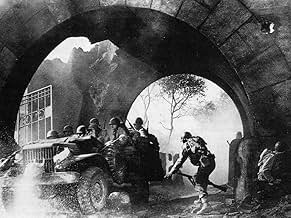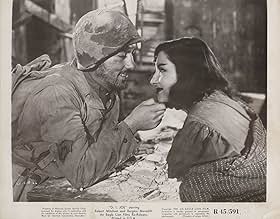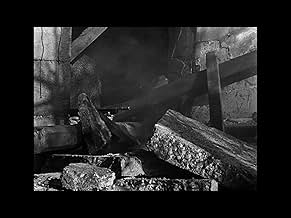IMDb RATING
7.2/10
4.1K
YOUR RATING
At the close of WWII, Pulitzer Prize-winning war correspondent Ernie Pyle travels with, and reports on, the U.S. Army's 77th Infantry Division during their liberation of Italy.At the close of WWII, Pulitzer Prize-winning war correspondent Ernie Pyle travels with, and reports on, the U.S. Army's 77th Infantry Division during their liberation of Italy.At the close of WWII, Pulitzer Prize-winning war correspondent Ernie Pyle travels with, and reports on, the U.S. Army's 77th Infantry Division during their liberation of Italy.
- Nominated for 4 Oscars
- 5 wins & 8 nominations total
John R. Reilly
- Private Murphy
- (as Jack Reilly)
William Murphy
- Private Mew
- (as Bill Murphy)
William 'Billy' Benedict
- Pvt. Whitey
- (uncredited)
Michael Browne
- Sergeant
- (uncredited)
Bob Hope
- Bob Hope (Voice on Radio Program)
- (voice)
- (uncredited)
Kenneth Kendall
- Extra
- (uncredited)
Yolanda Lacca
- Amelia, Italian Girl
- (uncredited)
Barney Noto
- Staff Sergeant Barney Noto
- (uncredited)
Tito Renaldo
- Lopez
- (uncredited)
Dick Rich
- Sergeant at Showers
- (uncredited)
William Self
- Pvt. Cookie Henderson
- (uncredited)
Featured reviews
I entered for 17 weeks of infantry basic training at Camp Roberts California in January,1945. I was just 18. I was in the 96th, inf, training battlion. I am 73 now. The movie about Ernie Pyle was being made there in part. Some of the trainees were in the film. I recall my company marching over and over on this same hill to make it look like there was a full army there for the picture. My company commander was in the film as was the company mascot dog. I can't recall much more about the film as I have'nt seen it in a long time, getting old I guess. I surely would like to have a VCR copy of it too. If anyone has a copy to sell, please let me know. I recall that Burgess Meredith had lunch in the mess hall and shot the bull with the G.I.s there. Thats about all that I can remember for now. Hope this helps. G
After searching for the best war films all my life, and after seeing so much tripe, I was completely flabbergasted by this film, of which I had heard, but had never seen until last night. Most films made during the Second World War were pure propaganda, all dash and glory, but with little resemblance to real battle. "The Story of G.I. Joe" is the real McCoy, especially considering that it was made near the end of the war. You can feel, taste and smell the muck and fear these men lived with. The dialogue is gritty, the combat scenes, especially of urban fighting bang on. One exceptional and rare scene was of an anti-tank gun crew swinging into action and firing 12 rounds a minute in a town. It was a battle ballet and an example of the lethality of a well-trained and seasoned team. In my opinion, this film ranks with Steven Spielberg's "Saving Private Ryan" as the best film of infantry in combat ever made. In fact, I believe that Spielberg may even have made 'Ryan' as an homage to Wellman's great earlier film; many of the scenes and much of the dialogue is very similar. In 1945, General Eisenhower called 'G.I. Joe' the greatest war film ever made. I'm sure he would say the same thing today. This should be a must-see for every student studying this country's fighting history and every American in uniform should see it.
It's odd that a director noted for his aviation films would choose to direct a film about the infantry, but William Wellman knew a great subject when he saw it. Remember he also did the deservedly highly acclaimed Battleground.
Independent producer Lucas Cowen got together with Ernie Pyle and approached Wellman. They left copies of the stories Pyle wrote from the front in Africa and Italy and Wellman read them in a night's sitting and agreed to do the film.
The Story of GI Joe is based on the various stories and characters that World War II's most famous correspondent encountered. In fact aside from Robert Mitchum and a couple of other actors, the men in this film are real GIs who were in transit from the European to the Pacific Theater and a lot were killed after they arrived in the Pacific as did the real Ernie Pyle who never got to see the finished product.
Burgess Meredith does a fine job recreating the modest chronicler that was Ernie Pyle. In civilian life aside from news stories, Pyle was famous for his cross country travels and stories he wrote about people from all walks of life. Very much like the late television commentator Charles Kuralt did on CBS morning news on Sundays.
When war broke out Pyle did not cover the war of the generals, he spent his time with the troops and told their story. For that he was respected and beloved as now other war correspondent has ever been before or since. In this film Pyle is introduced to the men of one company which transports him to that first American battle and defeat at Kasserine Pass in north Africa. And he runs into them again and again through Sicily right to the liberation of Rome.
Robert Mitchum plays the lieutenant later captain in charge of this company. He'd broken into films with some Hopalong Cassidy pictures and did bits in other films. In fact when its cowboy star Tim Holt enlisted in the armed forces, RKO pictures had signed Mitchum to be his replacement and he'd done two films Nevada and West of the Pecos when he read for the part of Lieutenant Walker.
If it weren't for this film, Robert Mitchum might have continued to be a B picture cowboy star. For his portrayal of the stern, but compassionate officer in whom Pyle finds a kindred spirit, Robert Mitchum got his only Academy Award nomination for Best Supporting Actor. He lost that year to James Dunn for A Tree Grows in Brooklyn. He never received another nomination, but he certainly became a legend although he'd have been the first to debunk that title.
Lots of newsreel footage from the Mediterranean theater make The Story of GI Joe one of the most realistic war films ever done. That's remarkable too, considering most of the Hollywood product back then was propaganda hype, good and bad. It has remained a classic to this day and a wonderful tribute to that chronicler of the infantry, Ernie Pyle.
Independent producer Lucas Cowen got together with Ernie Pyle and approached Wellman. They left copies of the stories Pyle wrote from the front in Africa and Italy and Wellman read them in a night's sitting and agreed to do the film.
The Story of GI Joe is based on the various stories and characters that World War II's most famous correspondent encountered. In fact aside from Robert Mitchum and a couple of other actors, the men in this film are real GIs who were in transit from the European to the Pacific Theater and a lot were killed after they arrived in the Pacific as did the real Ernie Pyle who never got to see the finished product.
Burgess Meredith does a fine job recreating the modest chronicler that was Ernie Pyle. In civilian life aside from news stories, Pyle was famous for his cross country travels and stories he wrote about people from all walks of life. Very much like the late television commentator Charles Kuralt did on CBS morning news on Sundays.
When war broke out Pyle did not cover the war of the generals, he spent his time with the troops and told their story. For that he was respected and beloved as now other war correspondent has ever been before or since. In this film Pyle is introduced to the men of one company which transports him to that first American battle and defeat at Kasserine Pass in north Africa. And he runs into them again and again through Sicily right to the liberation of Rome.
Robert Mitchum plays the lieutenant later captain in charge of this company. He'd broken into films with some Hopalong Cassidy pictures and did bits in other films. In fact when its cowboy star Tim Holt enlisted in the armed forces, RKO pictures had signed Mitchum to be his replacement and he'd done two films Nevada and West of the Pecos when he read for the part of Lieutenant Walker.
If it weren't for this film, Robert Mitchum might have continued to be a B picture cowboy star. For his portrayal of the stern, but compassionate officer in whom Pyle finds a kindred spirit, Robert Mitchum got his only Academy Award nomination for Best Supporting Actor. He lost that year to James Dunn for A Tree Grows in Brooklyn. He never received another nomination, but he certainly became a legend although he'd have been the first to debunk that title.
Lots of newsreel footage from the Mediterranean theater make The Story of GI Joe one of the most realistic war films ever done. That's remarkable too, considering most of the Hollywood product back then was propaganda hype, good and bad. It has remained a classic to this day and a wonderful tribute to that chronicler of the infantry, Ernie Pyle.
War Correspondent Ernie Pyle (Burgess Meredith) joins an Infantry company led by Lt. Walker (Robert Mitchum) in North Africa. The men are surprised when Ernie decides to accompany them all the way to the front. After Kasserine Pass, they find themselves in Italy. They fight up the boot and is halted in front of Monte Cassino.
It is a relatively realistic portrait of war considering the times. Ernie Pyle is a real Pulitzer Prize-winning war correspondent killed in Okinawa two months before the movie's release. It uses many of his writing which contributes to the realism. He really paints a picture with his words. It doesn't always get the visceral grim reality with the interior studio sets. It always looks better outdoors. They create a great location which does look like a bombed out Italian town. Monte Cassino is mostly interior shoot as the fighters go underground. The monastery is no longer standing anyways but there is footage of the bombing. This is as real as it gets for its time.
It is a relatively realistic portrait of war considering the times. Ernie Pyle is a real Pulitzer Prize-winning war correspondent killed in Okinawa two months before the movie's release. It uses many of his writing which contributes to the realism. He really paints a picture with his words. It doesn't always get the visceral grim reality with the interior studio sets. It always looks better outdoors. They create a great location which does look like a bombed out Italian town. Monte Cassino is mostly interior shoot as the fighters go underground. The monastery is no longer standing anyways but there is footage of the bombing. This is as real as it gets for its time.
The Story of G.I. Joe chronicles the experiences of an infantry unit in Italy as told by war correspondent Ernie Pyle, who is played by Burgess Meredith. War weary Robert Mitchum plays the platoon leader. While we can see that the movie was largely made in the studio, the great photography and direction move it along. Cold feet, mud, frustration, and homesickness are effectively demonstrated at the expense of battle scenes.
Did you know
- TriviaThe extras in the film were real American GIs, in the process of being transferred from the war in Europe to the Pacific. Many of them were killed in the fighting on Okinawa--the same battle in which Ernie Pyle was killed by a Japanese machine gunner--never having seen the movie in which they appeared.
- GoofsThe unit Pyle is with--the 18th Infantry Regiment, 1st Infantry Division--never fought in the Italian campaign. After the Sicilian campaign ended, it was brought back to England and began training for the D-Day invasion in Normandy. The 1st Division would eventually spearhead the assault on Omaha Beach.
- Quotes
Pvt. Dondaro: If this War don't kill me first, my feet will.
- Crazy creditsThere are absolutely no credits at the end of the film, not even the words "The End".
- ConnectionsEdited from La bataille de San Pietro (1945)
- SoundtracksSilent Night
(uncredited)
Music by Franz Xaver Gruber
Lyrics by Joseph Mohr
Sung by Elfie Mayerhofer on Decca Record
- How long is Story of G.I. Joe?Powered by Alexa
Details
- Release date
- Country of origin
- Languages
- Also known as
- También somos seres humanos
- Filming locations
- Iverson Ranch - 1 Iverson Lane, Chatsworth, Los Angeles, California, USA(marching through countryside just before the "baptism of fire.")
- Production company
- See more company credits at IMDbPro
Box office
- Budget
- $1,000,000 (estimated)
- Runtime1 hour 48 minutes
- Color
- Aspect ratio
- 1.37 : 1
Contribute to this page
Suggest an edit or add missing content

Top Gap
By what name was Les Forçats de la gloire (1945) officially released in India in English?
Answer






























